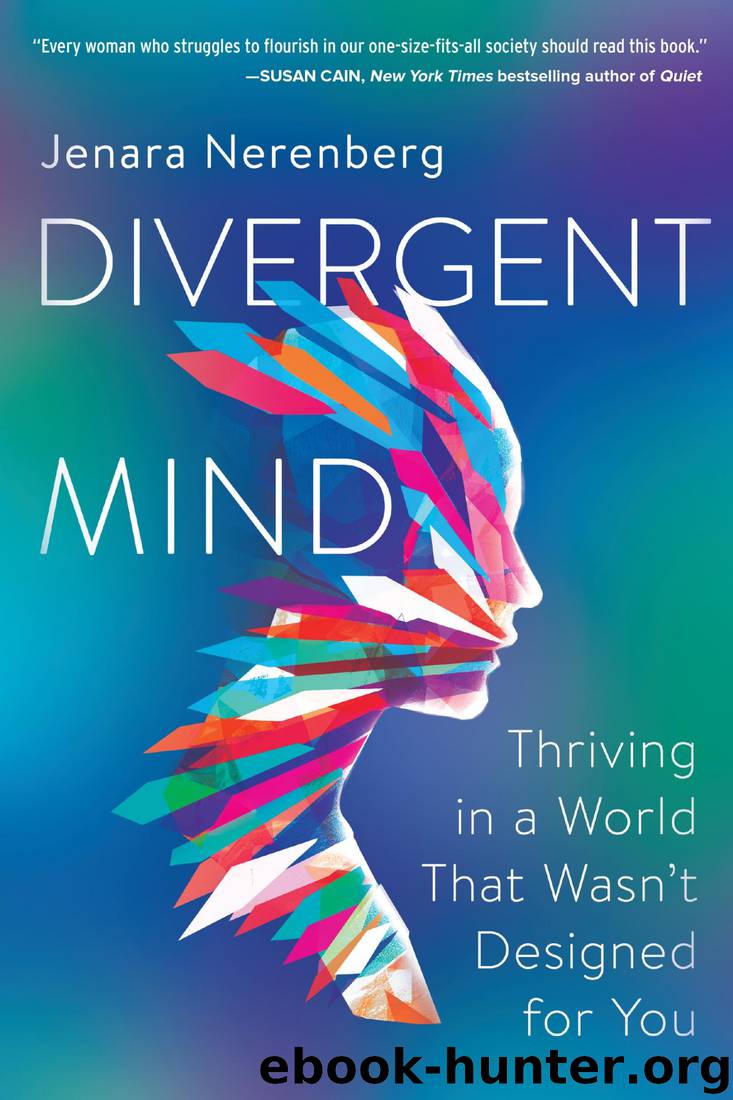Divergent Mind: Thriving in a World That Wasn't Designed for You by Jenara Nerenberg

Author:Jenara Nerenberg
Language: eng
Format: epub
Publisher: HarperOne
Published: 2020-03-24T00:00:00+00:00
Chapter 6
Home
Home, for me, is about environment and relationships. I have always felt deeply affected by my surroundings—feelings of sadness as a child when I was in sterile suburbs or office buildings, or feelings of joyful awe when I was by the ocean. And I think for sensitive neurodivergent folks, not only are we particularly affected by our environments, but we experience our environments differently to begin with because of our sensory sensitivities.
The same is true of our relationships—we experience the human dynamic differently because of our sensitivities. It is because of this that I would argue that our umvelt—a term from the German word Umwelt meaning “environment” and used to describe our sensory world—can be assumed to be experienced differently from neurotypical people as well. I think it’s time that we take seriously the differing umvelts of autistic, SPD, HSP, synesthetic, and ADHD folks as well—and create a world that we can all feel at home in.
Reframing Design for Sensitivity
A former designer at the design firm IDEO, author Ingrid Fetell Lee spent a decade researching what she calls the “aesthetics of joy.” Through research with psychologists, designers, historians, and others, she came to see a clear link between one’s environment and mental health and well-being. In her 2018 book Joyful: The Surprising Power of Ordinary Things to Create Extraordinary Happiness, she flips the script on what we think of as “overstimulating” versus “understimulating.”
“If you think about nature as the baseline for what our senses are good at processing,” she tells me, “nature isn’t silent, quiet, or still—nature is always moving—and yet it’s the most calming setting we have access to.” So although we might discount loud noises or lots of movement as sources of calm, Lee questions such assumptions. “I think we mistake something that’s calming for something that’s less stimulating, when in fact I think a lot of our environments are understimulating.” She points to a concrete dorm room or apartment, for instance, as being “a problem of understimulation.”
Lee tells me about Snoezelen “multisensory environments,” developed in the Netherlands, where autistic kids are exposed to cozy, soothing, darkened rooms with purple and blue patterned lighting, almost like a psychedelic room from the 1960s or the set of an Austin Powers movie. Snoezelen is a burgeoning practice, Lee tells me, but it makes one question our concepts of light and pattern and stimulation. She thinks one of many of the challenges with modern architecture, office design, room layouts, and other environments is that human beings are not being given the right kind of stimulation. It’s not about over- or under- or bad or good, but finding your sweet spot. So if you want to paint a room orange or yellow—traditionally considered “bright” colors—you could play with how much white to add to the color, she says, to figure out the hue that soothes your senses.
I asked Lee about how mental health and well-being are being discussed within architecture and design as professional fields, because when I was in grad
Download
This site does not store any files on its server. We only index and link to content provided by other sites. Please contact the content providers to delete copyright contents if any and email us, we'll remove relevant links or contents immediately.
The Art of Thinking Clearly by Rolf Dobelli(8889)
The 5 Love Languages: The Secret to Love That Lasts by Gary Chapman(8560)
Mindhunter: Inside the FBI's Elite Serial Crime Unit by John E. Douglas & Mark Olshaker(7871)
Becoming Supernatural by Dr. Joe Dispenza(7136)
The Road Less Traveled by M. Scott Peck(6667)
Nudge - Improving Decisions about Health, Wealth, and Happiness by Thaler Sunstein(6657)
Enlightenment Now: The Case for Reason, Science, Humanism, and Progress by Steven Pinker(6430)
Win Bigly by Scott Adams(6338)
Mastermind: How to Think Like Sherlock Holmes by Maria Konnikova(6270)
The Way of Zen by Alan W. Watts(5823)
Factfulness: Ten Reasons We're Wrong About the World – and Why Things Are Better Than You Think by Hans Rosling(4038)
The State of Affairs by Esther Perel(3960)
Gerald's Game by Stephen King(3942)
Man's Search for Meaning by Viktor Frankl(3667)
The Confidence Code by Katty Kay(3593)
Thinking in Bets by Annie Duke(3553)
The Worm at the Core by Sheldon Solomon(2942)
Enlightenment Now by Steven Pinker(2931)
Liar's Poker by Michael Lewis(2830)
